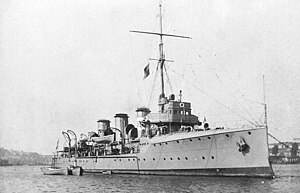
| |
| Class overview | |
|---|---|
| Name | Pathfinder class |
| Builders | Cammell Laird, Birkenhead |
| Operators | |
| Preceded by | Forward class |
| Succeeded by | Sentinel class |
| Built | 1903–1905 |
| In commission | 1905–1919 |
| Completed | 2 |
| Lost | 1 |
| Scrapped | 1 |
| General characteristics (as built) | |
| Type | Scout cruiser |
| Displacement | 2,940 long tons (2,987 t) |
| Length | 370 ft (112.8 m) (p/p) |
| Beam | 38 ft 9 in (11.8 m) |
| Draught | 15 ft 2 in (4.6 m) (deep load) |
| Installed power |
|
| Propulsion | 2 Shafts, 2 triple-expansion steam engines |
| Speed | 25 knots (46 km/h; 29 mph) |
| Range | 3,400 nmi (6,300 km; 3,900 mi) at 10 knots (19 km/h; 12 mph) |
| Complement | 289 |
| Armament | |
| Armour |
|
The Pathfinder-class cruisers were a pair of scout cruisers built for the Royal Navy in the first decade of the 20th century. The sister ships spent much of the first decade of their careers in reserve. When the First World War began in August 1914 they were given coastal defence missions, Pathfinder on the coast of Scotland and Patrol on the coast of Yorkshire. The latter ship was badly damaged when the Germans bombarded Hartlepool in December. She spent the rest of the war in British waters. The ship was paid off in 1919 and sold for scrap the following year. Pathfinder was sunk by a German submarine shortly after the war began, the first sinking of a British warship during the war by a German submarine.